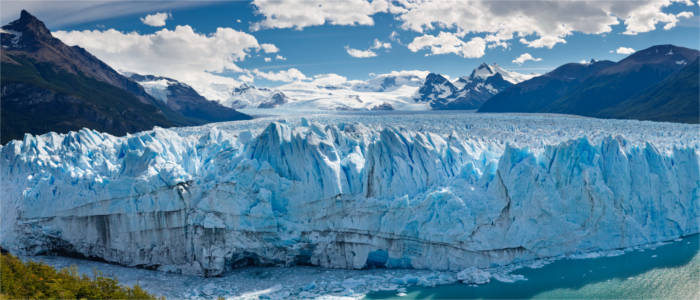Travel Offers
Travelmyne Featureprint
Distance
Patagonia (Argentina) - Nature at its Best
Patagonia's landscape is an exception in many ways. The endless vastness of the Pampa, unique volcanoes and rock formations as well as impressive glaciers are not only beautiful to look at but also offer excellent conditions for a variety of outdoor activities.

Geography - South America's southernmost landscape
Patagonia is a geographical region in the south of South America, which expands over the countries of Chile and Argentina. It borders on the Río Colorado in Argentina and the Río Bío Bío in Chile as well as on the Strait of Magellan and is divided into the regions of Western Patagonia (Chile) and Eastern Patagonia (Argentina) by the mountain ranges of the Andes. The Argentinian part of Patagonia has an area of almost 765,000 km² and contains the provinces of Neuquém, Río Negro, Chubut, Santa Cruz and Tierra del Fuego. In addition, Patagonia's landscape can be divided into subregions: the Southern Andes, the Patagonian Meseta, Patagonia's Atlantic coast and the Tierra del Fuego. The climate in these regions is very different. While it is temperate at the Atlantic coast with warm summers and mild winters, the Meseta has a continental climate with warm summers and cold winters. The weather in the Southern Andes, on the other hand, is humid and cool throughout the year.

Nature - From vast steppes and great lakes to impressive glaciers
Patagonia's landscape is a unique and diverse mix of wonderful lakes and rivers, fjords, glaciers, great forests, vast steppes (Pampas) and impressive volcanoes. The region is located in the shade of the Andes and is mostly dominated by the vast, barren, dry and harsh escarpments of the Meseta. Numerous plateaus, low mountain ranges, temporary lakes and bodies of salt water are waiting to be discovered. The Atlantic coast is most of all known for its deserted beaches and its intact fauna consisting of penguins, dolphins, sea lions, elephant seals and whales. Valdes Peninsula, which was declared a World Natural Heritage site in 1999, is one of the most popular destinations at Patagonia's coast. Another Natural Heritage site in the Argentinian part of Patagonia is the Los Glaciares National Park in the Southern Andes. It accommodates the Perito Moreno Glacier, one of the greatest glaciers outside of Antarctica. Besides the granite mountain of Monte Fitz Roy, which is 3,406 metres high, this glacier is one of the park's and Patagonia's main attractions. You also find the Nahuel Huapí National Park in the Southern Andes, which offers a breathtaking panorama of mountains, forests and lakes. The bodies of water in this park such as the Nahuel Huapí are fed by the glaciers in the Southern Alps. The national park of the same name is also home to several animal species like the guanaco, greater rhea, deer, boar, otter, armadillo and puma.

Culture - Following the traces of Patagonia's native inhabitants
Patagonia probably owes its name to its discoverer Ferdinand Magellan. The Portuguese sailor called the Native Americans he met on his expeditions "patagones", which means as much as "big foot". Most of Patagonia's native inhabitants were hunters and fishermen, which already populated the region 10,000 years BC and lived on local animal species like the guanacos or greater rheas. The Native Americans in Patagonia were nomads, which is why they did not leave any settlements but several cave paintings. One of them is the Cueva de las Manos in the province of Santa Cruz. The cave paintings, especially those depicting hands, have been part of the UNESCO World Cultural heritage since 1999.

Experience - Sheep farming and Patagonian barbecue
Patagonia's main branches of economy are the tourism, oil production, fruit and vegetable cultivation as well as sheep farming. The latter is obvious as half of Patagonia consists of pastures. The fluffy animals are often accompanied by gauchos, South America's cowboys. They wear bloomers, a beret, a scarf and spores on their boots and practice stationary, extensive ranching on their estancias (a kind of cattle farm). The sheep, however, are not only kept for their wool but also for their meat. In contrast to expensive beef, lamb is a common ingredient in the local dishes. The Patagonian barbecue, during which a lamb is cooked over a charcoal grill for several hours, is particularly popular.

Activities - A dream come true for every active holidaymaker
Patagonia is an eldorado for lovers of nature and active holidaymakers. The harsh, diverse landscape offers great conditions for a number of outdoor activities. The nature of the Andes and their national parks invite travellers to go trekking, mountaineering, rafting, riding, paragliding, ice hiking and skiing, while the coastal areas are suited for all kinds of water sports. The Ruta Cuarenta, which crosses Patagonia, challenges motorsports fans to a unique tour through the region's breathtaking landscape.

Information
The best time for a trip to Patagonia is from October to April (peak season: December to January). The Argentinian summer months have temperatures of up to 25 °C and longer days, while the winter (May to September) is very cold and rich in snow. There are high winds all year, some of which carry cool air with them. You best arrive by plane at the airport in Buenos Aires. From there, you can continue your journey by bus, train or national airlines.
Patagonia arouses the spirit of adventure in every active holidaymaker. The unique mix of impressive mountains, unique volcanoes, magnificent glaciers and untouched steppes captivates every lover of nature.

















